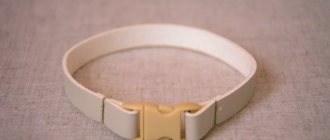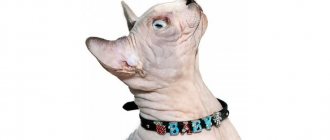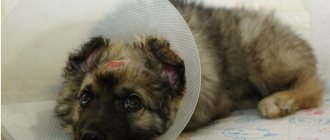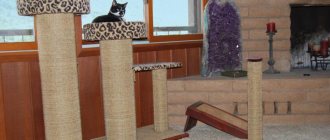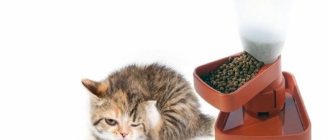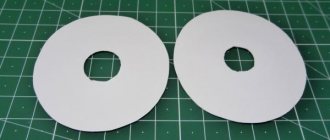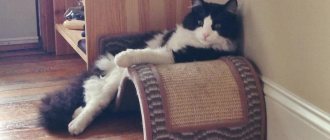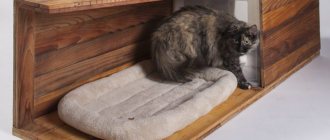It is generally accepted that a cat walks on its own. Therefore, for the most part, only dogs are kept on a leash. In modern cities, cats spend their lives in confined spaces in apartments without any problems. Few owners will risk freely letting their pet outside, because there are many dangers in the form of cars, dogs and unkind people. A harness will help you avoid these problems.
- 2 Types of harnesses for cats
- 3 In what cases should you not walk with a harness?
3.1 Accustoming the cat to a harness
- 5.1 Video - how to make a harness for a cat with your own hands
Why a harness and not a collar with a leash?
Alas, friends, the collar is not suitable for mustachioed and striped ones for city festivities, because:
- This is a traumatic type of control: it puts direct stress on the furry’s neck. With a sharp jerk, a pet can cause injury to its delicate throat and cervical vertebrae.
- Unreliable type of fixation. The cat, I don’t know how, but somehow miraculously almost always manages to pull its head out of the collar and gain the long-awaited freedom. Then catch the runaway on some tree.
You should know:
It is easiest to train a furry pet to go for walks at a young age. And an adult animal, when trying to walk for the first time, can get very stressed: break out of the collar, run away, and get lost. Therefore, a harness is a more reliable and convenient option.
When should you not walk with a harness?
Almost all cats love to walk. But there are cases when the animal does not need to be taken outside on a harness.
In some cases, it is better not to take the cat outside
It is better to refrain from walking in the following situations:
- If your pet does not have the necessary vaccinations. This is especially true for small kittens that have not reached 5 months. Immunity does not develop immediately, so it is better to refrain from going outside for now. It is very easy to get an infection.
- Harness walks should be postponed if the cat has recently suffered a serious illness or surgery.
- An animal should not be taken out during estrus.
- Shy, unbalanced and nervous cats may never adapt to unfamiliar conditions, so it is better not to take such animals out for walks at all. When putting on a harness, sometimes they react extremely inappropriately. There will be little benefit from such promenades, because stressful situations negatively affect the general immune system and cause heart pathologies.
- Animals that are too aggressive are also not allowed outside, since fights are guaranteed in this case.
- It is better not to try to accustom an elderly pet over 10 years old who has never walked on a harness before to using this device. This can have a detrimental effect on the cat's health.
It is not recommended to take pregnant or lactating cats outside, as there is a risk of contracting infectious diseases. The immune system in this state is weakened and the body is more susceptible to various diseases.
Getting your cat used to a harness
It’s a rare cat who calmly accepts the design placed on it. Most often, the animal tries to get rid of an unfamiliar object that is bothering it. Therefore, you can start learning from a very early age.
The kitten must first be introduced to the harness and leash.
Small kittens usually get used to wearing a harness very easily. From the age of three months, babies gradually begin to learn. First, the pet is simply introduced to the accessory. To do this, the object is placed where the toys are or near the bowl. The item will be saturated with familiar odors and will not cause anxiety in the animal. After a couple of days, the harness can be put on the kitten for a short time. In this case, you should carefully and carefully tighten all the fasteners, the pet should be comfortable. Your fingers should fit freely under the straps. After 10–15 minutes, the product is removed.
Types of walking equipment for cats
Manufacturers offer a large number of models. Their appearance and name depend on the shape of the belts and their connection to each other. For example:
- The 8-shaped ammunition is made of two rings of straps and is shaped like a number;
- The V-shaped harness differs from the first type by the addition of a lower jumper. It runs along the tummy and relieves pressure on the purr's neck. And the straps themselves cover the cat’s neck on both sides and resemble a letter of the Latin alphabet. This model does not prevent the fluffy from moving freely during a walk.
- The H-shaped model differs from previous harnesses in the presence of an upper jumper; a belt ring is securely attached to it.
- Cat clothes with a fastening ring act as a beautiful, comfortable harness. The models are made in the form of colorful vests or insulated overalls. Often, cat owners like to make this type of equipment themselves.
The photo shows the main types of walking equipment:
What should you pay attention to when choosing a tray with a grid?
When choosing a tray with a grid, it is recommended to pay attention to:
- The material from which the device is made. Plastic should not emit a strong odor. Don’t be shy to smell the product in the store, because the health of your pet and the rest of the home’s inhabitants is at stake. In addition, the plastic must be durable, otherwise the structure will quickly become unusable, breaking or bending under the weight of the animal.
- Grate height. Grids come in high and low. The first option is most preferable, since it allows you to pour more granules into the tray.
- The height of the sides. Trays come with high and low sides. Choosing the first option will allow you to avoid problems such as animals, especially older ones, flooding the walls of the device, the floor and nearby objects.
- Tray size. It must match the dimensions of the four-legged pet.
Source
Hand Made - necessity and love for creativity
Imagine that you are a handmade master and have created a real masterpiece in which your kitty will walk like “Mr. Cat” or “Princess”. Even the “Angel of Goodwill” can be demonstrated to everyone. A homemade suit will definitely be in the singular.
Let me note that the creative process can become a collective family activity: children love to help adults. As a result, the cat's family will become many times friendlier and stronger.
When choosing a design, new ideas and fantasies always come, and there is the Internet to help. The search will immediately offer various patterns that you can use.
Experienced needlewomen easily, simply come up with a style or model on their own in different color combinations. Craftswomen just have to see a few interesting features with their own eyes, and their imagination and hands will work at their best. And a new masterpiece will turn out quickly and without a pattern.
But for beginning cat fashion designers, of course, they will need step-by-step instructions to help them cope and please themselves and their furry little paw with a vest for a walk.
Types of harnesses for domestic and sled dogs
First of all, all types of harnesses can be divided according to their purpose:
Puppy and for small breeds. For compact sizes, custom tailoring is preferable.
Harness for puppies Cargo. They assume frequent physical training with weights, so they contain spare pockets.
Cargo harness Exhibition. They are distinguished by their special decor and maximum narrowing of the fastenings.
Exhibition harness Medical. Makes it easier to walk animals that have been injured or have paralysis of their limbs.
Medical harness Walking. They are used as often as possible, therefore, during production, they adhere to materials that have high wear resistance and strength.
Walking harness Sled. They are made of canvas and nylon, allowing them to withstand any conditions during competitions (for example, for huskies and huskies).
Riding harness Trace. They provide maximum freedom of movement, which is important for dogs that help in investigative work.
Trail harness
Among the materials used, it is important to highlight:
Skin. The presentable appearance wears out quickly. Any damage and moisture will deform the material. The harness becomes difficult to put on. Nylon. Does not add to the overall weight of the product, has high strength and durability. Attracts with its low price and easy care. Tarpaulin. Durable and well priced. It is not durable, difficult to wash and can take days to dry.
An obvious advantage is observed in nylon harnesses, but leather ones also have their advantages. They are used for service dogs that require stronger and wider belts that are comfortable and easy to put on.
Hand-Made Scheme
To get a beautiful harness, follow these steps step by step:
Step 1. Prepare a measuring tape, a large sheet of paper, a pencil, scissors, fabric, braid for finishing, threads, needles, pins, a metal half-ring for attaching a leash, fasteners or Velcro, as well as elements for decorating the finished product.
Step 2. Take measurements of your beloved pet as shown in the photo:
Step 3. Using the diagram on paper, draw a pattern and cut it out.
Step 4. Before transferring the pattern to the fabric, check the dimensions of the pet again, taking into account the length of the harness along the back.
Step 5. Fold a suitable piece of fabric in half along the grain thread. The fold line will be the center of the future clothing and the attachment point for the ribbon with the ring for the leash.
Step 6. Using the paper form, draw two blanks on the fabric.
Step 7. Cut out the drawn parts with a seam allowance of no more than one centimeter. Where one pattern will be the top side of the harness, and the other will be the lining.
Step 8. Sew the braid with a ring along the center line of the front piece, and then fold the two parts on top of one another, facing inward, and sew the product around the entire perimeter, taking into account the seam allowance.
Step 10. Turn the product inside out and iron it.
Final step: decorate the harness with the prepared decorations. And the handwork is ready!
Vest without pattern
To sew a vest for a cat, it is not necessary to draw complex patterns. All you need is an old sweater, scissors and some creative inspiration. The model in the picture shows a dog, but the proposed accessory is perfect for a cat of any breed.
Clothing suitable for both cats and miniature dogs
The step-by-step production of such a vest is presented below:
- the sleeve is cut off from a knitted sweater;
- draw a curved line with chalk next to the cut - on the stomach the vest should be shorter than on the back;
- cut off the excess along the marked line and overcast the edge. You can use either an overlocked hand stitch or an overlock stitch;
- The future vest is applied to the animal and the location of the holes for the paws is marked. The closer to the narrow edge the holes are made, the smaller the vest collar will be;
- Having folded the sleeve in half, reflect the marks for the holes symmetrically and cut them out. You can overcast the edge in any way.
After fitting, the craft is adjusted. If necessary, it can be sutured.
Little tips for beginners
- Make the first test ammunition, that is, cut it out of simple fabric that is no longer needed in everyday life. For example: from an old duvet cover.
- Try on a trial version, correct any errors, and then take into account all the corrections in the real version.
- Do not sew all the way around the edge of the harness, but leave 2-3 cm of the seam without stitching. Turn the product right side out through the hole left. Smooth out the edges, iron the finished harness, and carefully sew up the turning area by hand.
Taking measurements
Before creating a pattern, fix all the parameters of the pet:
Chest circumference. When measuring, focus on the widest point located behind the front legs. Neck circumference. Take measurements in the area where the collar is located. Back length. Measure the distance from the withers to the base of the tail.
Add 2 cm to the obtained values. This will help avoid a tight fit.
To make a pattern, buy a ready-made pattern in a store or print the version you like from the Internet. Attach the resulting pattern to the folded fabric, make marks and cut out 2 pieces.
